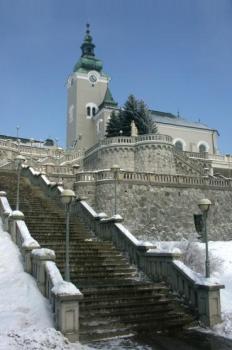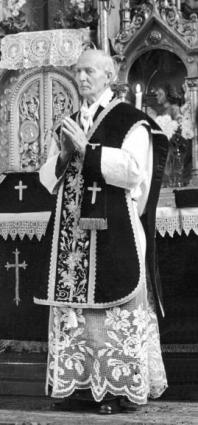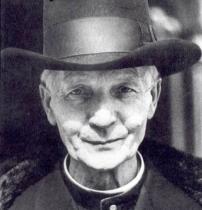Father Hlinka’s secret mission (1919)
It was a moonlight flit to try to redraw the map of Europe along religious lines. The self-appointed delegates sneaked out of their villages in Eastern Europe by night and wandered through half of Europe, often by foot, sometimes even retracing their steps to avoid detection. The papal nuncio advised them to wait until later, but they pressed on. For many years this expedition looked like a lost cause, yet more than 70 years later the Catholic Church finally managed to permanently separate the Slovaks from the influence of the more secular Czechs.
Father Hlinka's his huge mausoleum has long been a national shrine.and in 2007 he was officially proclaimed “Father of the Nation”. Who was Father Hlinka?
 ♦ Hlinka led the Slovak People’s Party from 1913 until his death in 1938, while also serving as papal chamberlain and papal protonotary.
♦ Hlinka led the Slovak People’s Party from 1913 until his death in 1938, while also serving as papal chamberlain and papal protonotary.
♦ Rejecting Czechoslovakian democracy, his party adopted the fascist motto, “One people, one party, one leader”. Father Tiso proclaimed this in a speech by (Piešťany, 19 September 1936), later becoming Hlinka’s political heir and president of wartime Slovakia.
♦ Hlinka held up Mussolini’s regime as a model, crediting it with having brought order, peace and prosperity to Italy. (Slovák, 8 December 1926)
♦ He established the Hlinka Guard, dressed in black, in imitation of Mussolini’s Blackshirts. When these armed thugs attacked his political opponents, (Czechs, liberals and leftists), e.g. in Prešov, 28 January 1923, he failed to firmly condemn them. [1]
♦ He integrated antisemitism into his Christian-nationalist revolutionary ideas, argued in his newspaper Nitra that Slovaks are the “slaves of Jews”. [2]
♦ For Father Hlinka, Slovaks must be Catholic. According to a slogan of the time, “First to go are the Czech bosses; next come the Jews and Protestants.” (D. Šmihula: Nové Slovo, October 1994)
Father Hlinka’s secret mission (1919)
In 2007 the Slovakian press was filled with the debate on the “Lex Hlinka”, the draft bill about the high merit of the late Catholic priest and former clerofascist politician, Andrej Hlinka, who created the Slovak sovereign State. The bill was written by the far-right, ultra-nationalist Slovak National Party and its original draft called for officially honouring Hlinka as “The Father of the Nation.”
Even in its final form [3] this law reads almost like a canonisation, minus the miracles. The “Act on the merit of Andrej Hlinka in creating the sovereign Slovak State” stipulates that a memorial be placed in the National Assembly with the inscription: “Andrej Hlinka had great merit in the Slovak nation and the Slovak Republic”. It also concerns itself with his mausoleum which is set in front of the baroque church where it towers over Andrej Hlinka Square in the centre of his hometown of Ružomberok (Rosenberg):
The visitor [or pilgrim?] to the mausoleum and its close environs is to behave with reverence for Andrej Hlinka and to abstain from everything which could disturb the peace of this place of piety.
Unfortunately, however, this venerated statesman appears to have been actuated by less than exalted motives. Father Hlinka had a deep mistrust of the Czechs, whom he saw as faithless people and he considered it his duty to keep the Catholic Slovaks away from these descendants of Hussite heretics. He also felt that the Lutheran minority didn’t belong in the Slovak nation and denied that true Slovaks could be anything but Catholic. [4]
Hlinka’s modern fans take his nationalistic utterances at face value, apparently unaware of his secret expedition to try to get the Paris Peace Conference at the end of World War I to help him redraw the map. It goes without saying that Hlinka’s political mission was purely self-appointed. No one gave him a mandate for this, least of all the Slovaks as a whole. However, that did not keep him from confidently speaking “on behalf of the nation”. Today’s Slovak nationalists seem to have no idea of their hero’s plan to undo the creation of post-war Czechoslovakia and leave the Slovaks under the domination of Hungary.
At the end of the First World War, the victorious Allies recognised the independence of Czechoslovakia from the Austro-Hungarian Empire. Before the end of the year Slovakia joined the new nation as a result of a formal declaration signed, among others, by Hlinka himself who admitted to declaring “that we Slovaks were a part of the Czechoslovak race and that we wished to live with them with equal rights in an independent state”.
Soon, however, he had doubts, and the next year he took part in a secret Slovak delegation, whose origin and mandate were unclear, (and which may well have been directed by Hungarian irredentists [5]). To escape detection, Hlinka and his group set out for Paris on a circuitous route, hoping to get there in time to be able to influence the Treaty of St. Germain) which was to set the new boundaries at the end of World War I. When they reached Luxemburg they hid in a monastery where they made contact with the Americans and met secretly with the linguist, author and diplomat, Stephen Bonsal.
 There, according to Bonsal, Hlinka revealed that he had changed his mind and, a year after helping the Slovaks join the Czechs, declared that it had all been a mistake and that they should join the Hungarians, instead. Bonsal was surprised, for the Czechs and Slovaks are ethnically the same and most dialects of Czech and Slovak are mutually intelligible. However, for Hlinka religion now trumped ethnicity. He proclaimed that the Slovaks could get along with the Hungarians in terms of religion “better, much better, than we can with the irreligious free-thinking Czechs”. And he added that “the religious barriers ... shall, I trust, always keep us Catholics apart from those who were Hussites and now are infidels”. Lapsing into Latin, Father Hlinka declared pathetically, “Now we realise that extra Hungariam non est vita” — outside of Hungary there is no life for us.
There, according to Bonsal, Hlinka revealed that he had changed his mind and, a year after helping the Slovaks join the Czechs, declared that it had all been a mistake and that they should join the Hungarians, instead. Bonsal was surprised, for the Czechs and Slovaks are ethnically the same and most dialects of Czech and Slovak are mutually intelligible. However, for Hlinka religion now trumped ethnicity. He proclaimed that the Slovaks could get along with the Hungarians in terms of religion “better, much better, than we can with the irreligious free-thinking Czechs”. And he added that “the religious barriers ... shall, I trust, always keep us Catholics apart from those who were Hussites and now are infidels”. Lapsing into Latin, Father Hlinka declared pathetically, “Now we realise that extra Hungariam non est vita” — outside of Hungary there is no life for us.
Hlinka further recounted that on the way they had travelled through Poland where they had met with the papal nuncio. This “ambassador” sent by the pope to Poland, would later become Pope Pius XI.
We also received kind words from another great man, Achille Ratti. He gave us his Apostolic blessing. He, too, deplored that Christendom had placed the devout Slovak congregations under the tyrannical rule of the enemies of the true Church. But he begged us to give up our journey, at least for the moment. He asserted that conditions were too unfavorable; that for the present they could not be overcome. [6]
The words of the nuncio proved true. The clandestine journey took three months, by which time the treaty had already been signed and there was no longer any point in Hlinka and his delegation pressing on to Paris. Little more than a week after they arrived in Luxemburg, these “unregistered aliens” were reported to the authorities and the local police put them on a train to send them home again.
However, before this self-appointed delegation was thrown out of France, it submitted a Memorandum in September 1919 which clearly states the wish of the Catholic Church to remove the Slovaks from the religious influence of the Czechs who “mean to wrest our Slovak soul from us”. [7]
The nation of Czechoslovakia lasted until the outbreak of World War II. And when the Slovaks finally parted company with the Czechs, it was not a free choice. In 1939, a year after Hlinka’s death, Hitler’s armies overran the western, Czech part, of Czechoslovakia and set up the eastern, Slovak part, as a Nazi puppet state. Certainly Father Hlinka could rightly be called the “father” of his posthumous Slovak state, for it was so tightly controlled by the Catholic Church that it was known as “the parish republic”. [8]
However, the pious republic that Hlinka bequeathed to Slovakia did not last long, for at the end of World War II, Czechoslovakia was re-established, (for the most part within the prewar boundaries), but now under Soviet domination and officially atheist.
When Communism ended in Czechoslovakia, the Vatican finally saw a realistic opportunity to separate the Slovaks from the Czechs, this time for good. Just a few months after the “Velvet Revolution”, the bloodless liberation from Communism, Pope John Paul II made his first trip to Czechoslovakia. He visited Prague, the capital of the Czech part of the federation and then flew on to Bratislava, the capital of the Slovak part. There the Pope kissed the ground, as if he had arrived in a different country. The message was understood. Three years later, after the “Velvet Divorce”, the president of the new Slovak Republic thanked the pope for encouraging the breakup of Czechoslovakia or – as he said diplomatically – for the “anticipated recognition of Slovak independence”. [9]
 This symbolic gesture was reinforced by the Catholic bishops in the crucial period before 1 January 1993 when Slovakia became independent. The chairman of the Czechoslovak bishops’ conference, as well as the Slovak bishops, accentuated the abstract right to self-determination and did not call for the referendum which “would have prevented the splitting up of Czechoslovakia”. [10] Instead, the Slovak bishops made constant attempts to link Catholicism with Slovak nationalism. They looked back to its pre-Communist past, to the last time when it had been an independent nation. This was Father Hlinka’s legacy, the fascist Slovak State of 1939-1945.
This symbolic gesture was reinforced by the Catholic bishops in the crucial period before 1 January 1993 when Slovakia became independent. The chairman of the Czechoslovak bishops’ conference, as well as the Slovak bishops, accentuated the abstract right to self-determination and did not call for the referendum which “would have prevented the splitting up of Czechoslovakia”. [10] Instead, the Slovak bishops made constant attempts to link Catholicism with Slovak nationalism. They looked back to its pre-Communist past, to the last time when it had been an independent nation. This was Father Hlinka’s legacy, the fascist Slovak State of 1939-1945.
The Church, the Christian political parties and a group of revisionist historians all began promoting the wartime Slovak state as a golden era, “an ideal society, where the Roman Catholic social doctrine prevailed”. [11] They lauded it, even though it was a German “protectorate” with a Nazi puppet regime and, above all, they lauded its founder, Hlinka. More than 70 years after Hlinka’s fruitless journey, his aim of permanently separating the Slovaks from the Czechs has been accomplished by the persistence of the Church. The “Velvet Divorce” has given the Church far more power than it ever had in Czechoslovakia. The Slovak bishops have even been able to draw up and implement a comprehensive plan to saturate the new country with Catholicism, a programme which the Czechs would hardly have accepted. “The Vatican thinks in centuries” and the papal nuncio was proven right when he counseled Hlinka to be patient.
Notes
1. Eduard Chmelár, “Kult osobnosti Andreja Hlinku”, 20 September 2007. http://chmelar.blog.sme.sk/c/112645/Kult-osobnosti-Andreja-Hlinku.html
2. Grzegorz Rossolinski-Liebe: Review of : Ward, James Mace: Priest, Politician, Collaborator. Jozef Tiso and the Making of Fascist Slovakia. Ithaca, NY 2013, in: H-Soz-u-Kult, 02.10.2013, http://hsozkult.geschichte.hu-berlin.de/rezensionen/2013-4-006
3. “Act on the merit of Andrej Hlinka in creating the sovereign Slovak State” (Act No 531 of 26 October 2007). http://www.zbierka.sk/zz/predpisy/default.aspx?PredpisID=207809&FileName=zz07-00531-0207809&Rocnik=2007 (Entry in the official Gazette: http://www.zbierka.sk/zz/predpisy/default.aspx?CiastkaID=25651)
§ 1
Andrej Hlinka had great merit in gaining statehood for the Slovak nation.
§ 2
To honour the exceptional merit of Andrej Hlinka cited in § 1 a bust of Andrej Hlinka will be placed in the building of the National Assembly of Slovakia with the following inscription: “Andrej Hlinka had great merit in the Slovak nation and the Slovak Republic”.
§ 3
1) The mausoleum of Andrej Hlinka is a place of piety
2) The visitor to the mausoleum and its close environs is to behave with reverence for Andrej Hlinka and to abstain from everything which could disturb the peace of this place of piety.
§ 4
This act comes into force on January 1, 2008.
4. Šmihula: Nové Slovo, October 1994.
5. Questions have been raised about Hlinka’s covert delegation: was it really a Slovak one? Or was it a Hungarian irredentist delegation? A leading member of the group was the Slovak Roman Catholic priest, journalist and politician, František Jehlička, who has been identified by both Czech author Drahomír Jančík and the Slovak politician, Ferdinand Juriga, (with whom Jehlička worked) as intent upon helping Hungary regain control of Slovakia. It was Jedlička who conceived a “Memorandum of Slovaks to the [Paris] Peace Conference” in French (which Hlinka did not speak), and sent it to all the delegations and press agencies. Curiously, the member of the official Hungarian delegation to the peace conference in Paris, Albert Aponyi, was commissioned by his government to demand the same, asking for a revision in uniting Slovakia with Czechoslovakia. When he left Paris, Jedlička went to Budapest where he founded the Hungarian-Slovak People’s Party which co-operated with Hlinka’s Slovak People’s Party. The programme of Jedlička’s party was to maintain the Hungarian borders unchanged, so that Hungary would include Slovakia.
Jančík, Drahomír Ve jménu národa - do Paříže! Cesta Andreje Hlinky na mírovou konferenci a zpět In: Pocta profesoru Zdeňku Kárníkovi. Acta Universitatis Carolinae - Philosophica et historica. Praha: Karolinum; p. 51-70. ISBN 80-246-0612-7
6. Stephen Bonsal, Suitors and Supplicants, Chapter 9: “The Czechs, Slovaks and Father Hlinka”, 1946. http://www.hungarian-history.hu/lib/bonsal/bonsal11.htm
7. “Memorandum Presented by the Slovak Autonomists to the Paris Peace Conference of September, 1919” in Henry Bogdan, From Warsaw To Sofia, 1989 (translation of De Varsovie a Sofia: Histoire des Pays de l'Est, 1982), "Chapter 16: Political Struggle and Internal Conflict 1919-1939". http://www.hungarianhistory.com/lib/bogdan/bogdan00.htm
8. This is the translated title of Dominik Tatarka’s famous 1948 Farská Republika, about the country's wartime totalitarian regime.
9. Frans Hoppenbrouwers, “Nationalistic Tendencies in the Slovak Roman Catholic Church”. Religion in Eastern Europe, Volume XVIII, Number 6, December 1998. The author is a Roman Catholic Church historian and secretary of studies of the Dutch Roman Catholic relief organisation, Communicantes. http://www.georgefox.edu/academics/undergrad/departments/soc-swk/ree/Hoppenbrouwers_Nationalistic_Dec%201998.pdf
10. Ibid.
11. Ibid.







 Church and state in Slovakia
Church and state in Slovakia